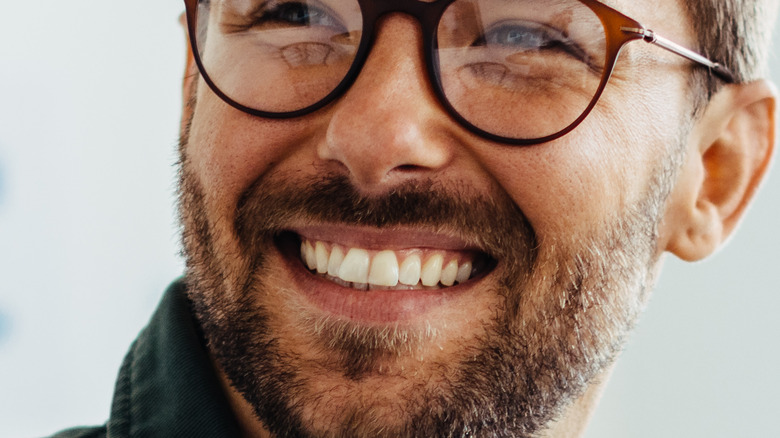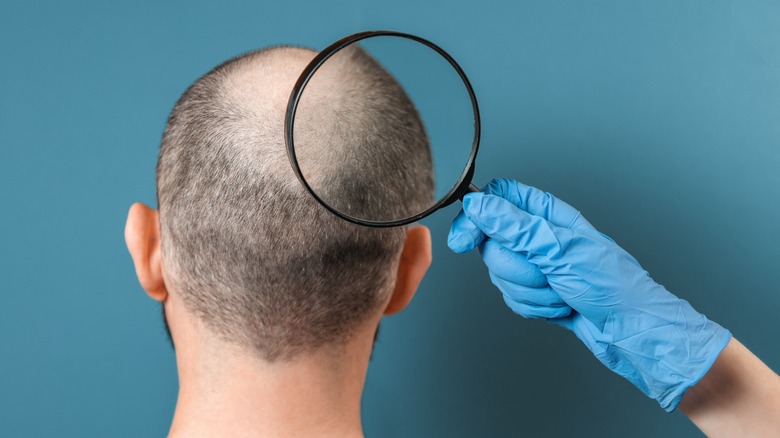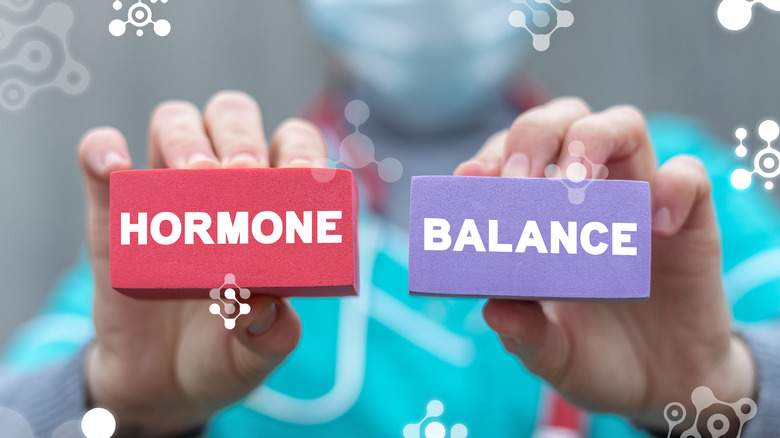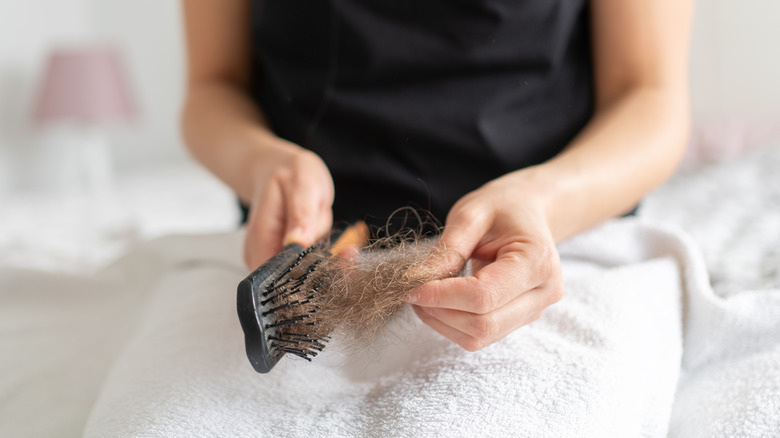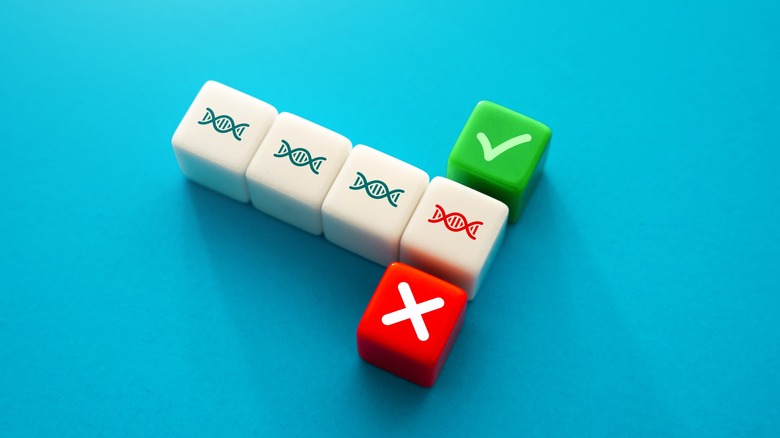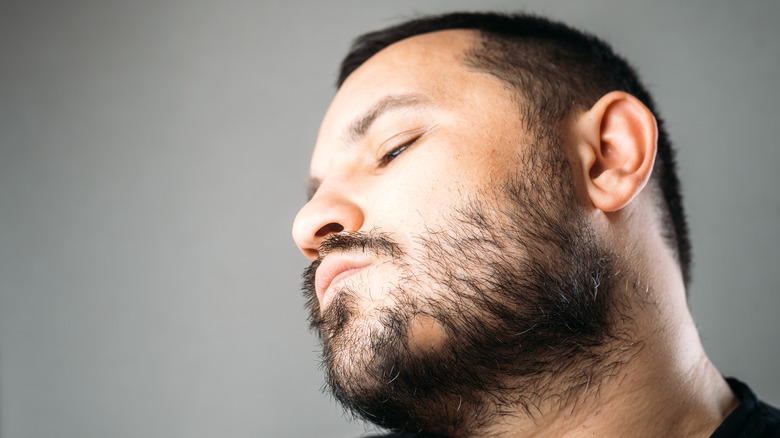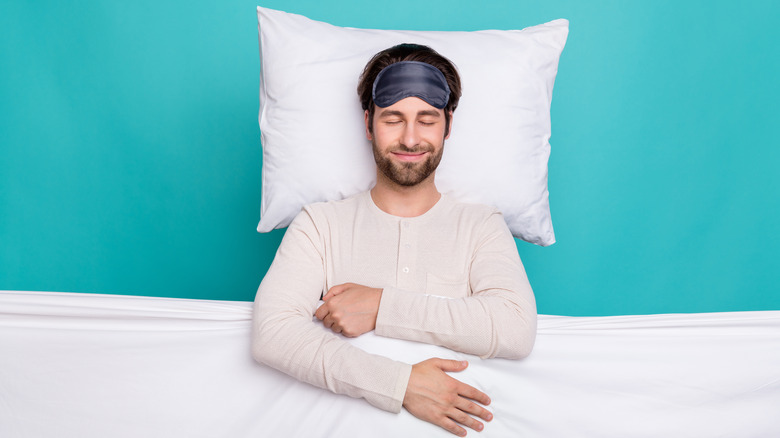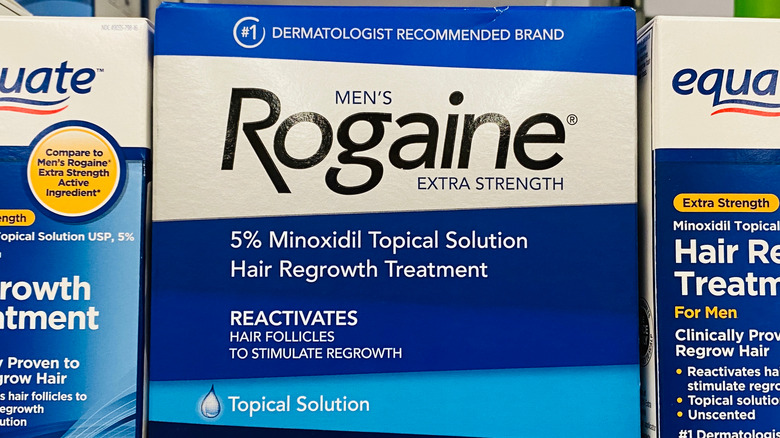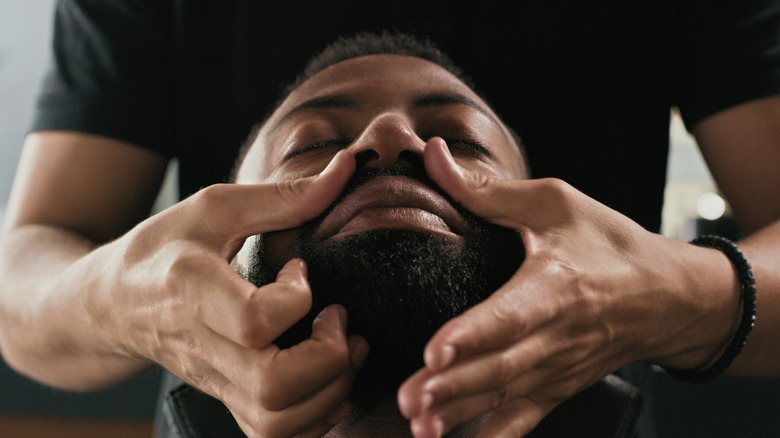Why Your Mustache Isn't Growing And How Long It Can Take To See Results
A mustache might seem like a small thing, but it can have a big impact on how men look and portray themselves. Defined as the hair that grows on the upper lip, mustaches can display things like traditions, beliefs, and preferences. As such, they have had their fair share of controversy throughout history. For instance, there were times when having a clean-shaven face was considered stylish, and having a mustache or beard made someone seem strange. Some places even had laws that made people shave their facial hair.
Yet mustaches carry far more meaning than simply being a fashion statement. According to a study published in the Journal of Evolutionary Biology, having or not having facial hair can tell you about a man's confidence and how appealing or attractive others see him. For example, having a nice mustache can signal various elements of a man's identity, such as age, perceived social dominance, and even his own sense of masculinity. In fact, per the study, women seem to often like men with facial hair more than those who are clean-shaven, especially for serious, long-term relationships.
So, given the role mustaches play in the life of men, it is no surprise that some might get frustrated when it doesn't seem to want to grow. This article explains why your mustache isn't growing and how long it can take to see results.
There are different stages for facial hair growth
Like your scalp hair, your mustache hair goes through different growth stages. Healthline explains that the first stage is called the anagen phase, marking the growth stage during which hair actively sprouts from the hair follicle. This phase can span several years and varies in length depending on factors like genetics and body location. Then, the catagen phase comes as a transitional period that follows anagen. During this phase, growth stops, but the hair is still not ready to fall out. Instead, the hair follicle shrinks and detaches from the hair shaft, and the hair follicle moves upwards towards the skin's surface. Finally, the telogen (resting) phase is when new hair begins forming in the hair follicles while the detached hair remains. Eventually, the new one pushes the old hair out, and the shedding process begins (aka the exogen phase).
Importantly, not all hairs are in the same phase at the same time. This is why you might notice some shedding while other hairs continue to grow. The timing and duration of each phase can be influenced by various factors such as age, health, and hormonal changes. Regarding facial hair, a study in the International Journal of Cosmetic Science explains that beard hair grows just as fast as scalp hair, with an average daily growth of about 0.3 to 0.5 millimeters. Additionally, the speed of hair growth may also be influenced by its color. White beard hair, for instance, can grow more than twice as fast as hair with color.
Your hormones may sabotage your 'stache
Hormones play a pivotal role in hair growth and loss. Among these hormones, a review published in the International Journal of Molecular Sciences explains that androgens, such as testosterone, take center stage, influencing hair follicles in unique ways depending on their location on the body. Yet, an even more important player in this hormonal balance is dihydrotestosterone (DHT), a derivative of testosterone known for driving the development of secondary male characteristics, such as facial hair growth (via the Cleveland Clinic).
However, disruptions in the hormonal balance can lead to conditions that directly affect facial hair growth. One such condition is isolated gonadotropin-releasing hormone deficiency (IGD), which, per another review published by GeneReviews, is characterized by low levels of sex hormones and stunted sexual maturation. Thus, individuals with IGD often lack secondary sexual features, such as facial and axillary hair growth.
Similarly, the Mayo Clinic explains that male hypogonadism (another hormonal condition caused by low testosterone levels) can delay the growth of body and facial hair during puberty and decrease hair growth on the face during adulthood. According to the review and the Mayo Clinic, medical interventions involving gradually increasing doses of testosterone can help mitigate these effects, helping individuals achieve more normal hair growth patterns.
Stress can affect facial hair growth
Researchers have recognized the link between stress and hair loss for quite some time. According to the National Institutes of Health (NIH), a 2021 study in mice found that the stress hormone corticosterone (which is equivalent to the human stress hormone cortisol) had a direct effect on hair growth. In the study, scientists removed mice's adrenal glands, which are responsible for producing said stress hormones in both mice and humans. The removal of these glands sparked rapid cycles of hair regrowth. Yet, when they fed the mice with corticosterone, their hair went back to growing normally. In a following test, researchers subjected mice to mild stress over extended periods, which significantly increased the levels of corticosterone. As a result, the mice's hair stopped growing. The outcome was hair follicles entering an extended resting phase or telogen, showing that stress and these hormones can mess up the normal hair growth process.
In addition, a condition called telogen effluvium, which is triggered by considerable stress, pushes numerous hair follicles into the telogen phase (via Mayo Clinic). This results in a sudden shedding of affected hairs within a few months, which can also affect facial hair. Luckily, telogen effluvium can be reversed once you get your stress under control.
It may be due to your genes or age
While you may influence some factors involved in mustache growth, there are some that you just can't control, such as your genes or age, which play a significant role in determining the kind and amount of facial hair you can grow. As dermatologist John Anthony, MD, said via the Cleveland Clinic, genes decide when your facial hair will reach its full potential. So, if you're between 18 and 30 years old and your beard (mustache included) isn't as full as you'd like, don't worry; during this time, many beards are still developing in terms of thickness and coarseness.
Regarding your genetic markup, a review published in Science and Justice explains that, among the genes responsible for hair traits, the EDAR gene plays a crucial role. Per the review, this gene is strongly connected to various hair characteristics, including how thick your beard is, the shape of your head hair, how thick the hair on your head is, hair loss, the thickness of your eyebrows, and even whether or not you'll have a single eyebrow or monobrow. Therefore, if you're wondering why your beard isn't quite there yet at 18, it might just be a matter of waiting. However, keep in mind that your genes also dictate whether a mustache is in the cards for you.
You may have alopecia areata barbae
Alopecia areata (AA) is a type of condition where the immune system mistakenly attacks hair follicles, causing hair loss in different parts of the body (via the American Academy of Dermatology Association (AAD)). According to a review published in the Journal of Clinical Medicine, among the commonly affected areas are the scalp and the beard, with the latter accounting for about 28% of cases and being known as alopecia areata barbae (AAB).
AAB usually causes hair to fall out in small, round shapes near the jawline. Sometimes, people might lose all the hair in their beard if the condition is more severe (via Healthline). While scientists don't know exactly why AAB happens, stress (both physical and emotional) seems to be related. Nevertheless, the site explains that genetics might contribute to an increased likelihood of getting AAB, especially if you have a family history of AA, asthma, or allergies. Moreover, per Healthline, facial hair loss can occur quite suddenly, within just a few days or over a few weeks after noticing your skin feeling itchy and painful in the beard area. According to the review, the most common method to treat AAB is by applying steroids (either through creams or injections) directly into the affected area. These treatments help calm the immune response and encourage hair to start growing again.
Your ethnicity and the seasons may be playing a role
Ethnicity and the time of year have been discovered to play a role in how facial hair grows. Per a study published in the International Journal of Cosmetic Science, different ethnic groups have hair that's not only different in color, length, and thickness but also in growth rate. For example, the study shares differences in beard hair growth between Japanese and Caucasian men, with Caucasians having a higher growth speed that results in them having up to eight times more hair than Japanese men. Additionally, it's not just the thickness or growth rate that varies; different ethnic groups also have different patterns of where facial hair grows. For instance, Chinese men have smaller areas of beard growth than Caucasians, with the focus of beard hair in Chinese men being mainly around the mouth. In contrast, Caucasians have more hair on the cheek, neck, and chin. Yet, both groups have the densest beard hair in the mustache area.
Moreover, research has even looked at how beard hair changes throughout the year. In an older study published in the British Journal of Dermatology involving healthy Caucasian men, scientists found that hair, including beard hair, grows differently depending on the season. Hair growth rates were slowest in the winter months (January and February), and then they picked up (increasing by up to 60%) and reached their peak in July, during the summer. Also, different parts of the beard can have different growth cycles, depending on where they are located on the face.
Following a healthy diet can help with your 'stache
Maintaining a healthy diet is more than just staying in shape, seeing that it can have a direct impact on hair growth too. While it is widely known that obesity affects both men and women, men experience an additional hair-related challenge when it messes with their testosterone levels (via Harvard Health Publishing). Though testosterone is expected to decrease by about 1% every year as men age, obesity can speed up this decline, potentially leading to prematurely lower levels of testosterone. Since this hormone plays a big part in growing facial hair, switching from a junk food diet to whole foods one might help boost mustache growth.
In addition, micronutrients (aka vitamins and minerals) can also influence hair growth, as they are essential for keeping your hair follicles working as they should. According to a review published in Dermatology and Therapy, vitamins such as A, B, C, D, and E, along with minerals like iron, selenium, and zinc, all play roles in hair health. They are like helpers that keep your hair growing strong and healthy and are especially important for normal hair development and keeping your immune system from attacking hair follicles (as it does in certain cases of alopecia). Thus, eating a balanced diet rich in these nutrients could actually help prevent hair loss and keep your mustache looking its best.
Getting enough sleep is vital for hair growth
Sleep plays a crucial role in keeping your body in balance, and this includes hormones (such as testosterone) that control facial hair growth. Per a study published in the Asian Journal of Andrology, when you don't get enough good-quality sleep or sleep is disrupted, it can impact your testosterone levels. This means that for someone with sleep problems like fragmented sleep (where their sleep gets interrupted a lot) or obstructive sleep apnea (a condition in which the upper airways get blocked while sleeping), their testosterone levels might go down.
Plus, another study published in the Journal of the American Medical Association explains that most testosterone is released during sleep and that even a short period of poor sleep can affect testosterone levels. In the study, young, healthy men who only slept for around 5 hours each night for a week experienced a 10% to 15% drop in their daytime testosterone levels, and believe it or not, this sleep restriction scenario is experienced by a significant portion of the working population in the U.S., according to the study. This highlights the strong connection between sleep and hormones and, most importantly, between sleep and mustache growth, given the direct link between testosterone and facial hair. So, making sure you get enough good-quality sleep is not only important for your overall well-being but also for maintaining healthy hormone levels that influence facial hair growth.
Using Rogaine (Minoxidil) for facial hair growth has mixed reviews
Rogaine is a popular brand of Minoxidil, and it is well-known for being an accessible over-the-counter solution for hair regrowth, typically used on the scalp. However, when it comes to facial hair, specifically mustache growth, Rogaine's effectiveness is less clear (via Healthline). Rogaine interacts with blood vessels around the hair follicle. It works by expanding the arteries that supply nutrients to the follicles during the anagen phase, when hair actively grows. However, it's important to note that Rogaine doesn't precisely restore hair that's completely lost. Its main strength lies in helping to preserve the hair you still have.
However, while this product is generally considered safe for most people to use and might sound like a potential solution for mustache growth, Healthline emphasizes that it's not actually known to help with it and that it is not officially approved by the FDA for promoting beard hair growth. In addition, it's important to be aware of potential side effects, which can include redness or irritation of the skin where it's applied and the potential for hair to grow in unexpected areas. So, while Rogaine can be beneficial for preserving hair on the scalp, its use for facial hair, particularly for mustache growth, might not yield the same results.
Give your mustache some love
Pampering your mustache can go a long way when it comes to having healthy facial hair, and resorting to beard oils can be a quick and easy way to give your 'stache some love. According to Healthline, while scientific evidence says that beard oils might not be magical growth elixirs for mustaches, they offer significant benefits in terms of hair and skin care.
As board-certified dermatologist Milton R. Moore, MD, explains via Byrdie, keeping your beard and mustache moisturized serves a purpose beyond reducing irritation, itching, and flaking, as it can also fortify brittle hair and help it achieve its optimal thickness. For that matter, both argan and jojoba oils (two common ingredients in beard oils) make excellent mustache-pampering oil choices. On the one hand, argan oil penetrates the hair shaft to hydrate it from the inside. In contrast, jojoba oil imitates the composition of the natural oils produced by your skin and, thus, provides external moisture and protection. Lastly, keep in mind that timing matters when it comes to getting the most out of your beard oil. Per Healthline, the optimal moment to apply it is right after you've washed your beard because this is when your pores are open and receptive, allowing your skin to absorb the oil efficiently.

